VUE系统学习八
Vuex 概述
1.Vuex是什么
Vuex 是一个 Vue 的 状态管理工具,状态就是数据。
大白话:Vuex 是一个插件,可以帮我们管理 Vue 通用的数据 (多组件共享的数据)。例如:购物车数据 个人信息数
2.使用场景
某个状态 在 很多个组件 来使用 (个人信息)
多个组件 共同维护 一份数据 (购物车)
3.优势
- 共同维护一份数据,数据集中化管理
- 响应式变化
- 操作简洁 (vuex提供了一些辅助函数)
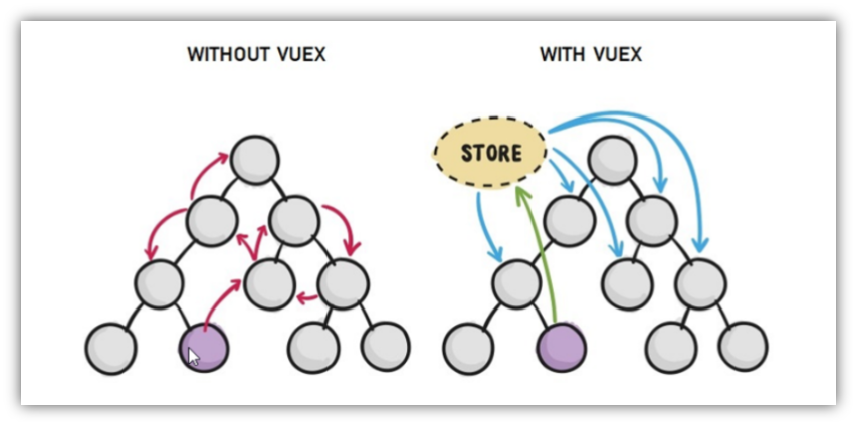
4.注意:
官方原文:
- 不是所有的场景都适用于vuex,只有在必要的时候才使用vuex
- 使用了vuex之后,会附加更多的框架中的概念进来,增加了项目的复杂度 (数据的操作更便捷,数据的流动更清晰)
vuex 的使用 - 创建仓库

1.安装 vuex
安装vuex与vue-router类似,vuex是一个独立存在的插件,如果脚手架初始化没有选 vuex,就需要额外安装。
1 | yarn add vuex@3 或者 npm i vuex@3 |
2.新建 store/index.js专门存放 vuex
为了维护项目目录的整洁,在src目录下新建一个store目录其下放置一个index.js文件。 (和 router/index.js 类似)
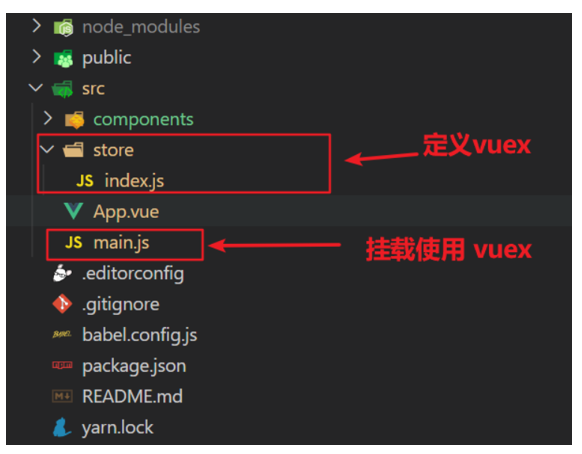
3.创建仓库 store/index.js`
1 | // 导入 vue |
4 在 main.js 中导入挂载到 Vue 实例上
1 | import Vue from 'vue' |
此刻起, 就成功创建了一个 空仓库!!
5.测试打印Vuex
App.vue
1 | created(){ |
核心概念 - state 状态
1.目标
明确如何给仓库 提供 数据,如何 使用 仓库的数据
2.提供数据
State提供唯一的公共数据源,所有共享的数据都要统一放到Store中的State中存储。
打开项目中的store.js文件,在state对象中可以添加我们要共享的数据。
1 | // 创建仓库 store |
3.访问Vuex中的数据
问题: 如何在组件中获取count?
- 通过$store直接访问 —>
- 通过辅助函数mapState 映射计算属性 —>
4.通过$store访问的语法
1 | 获取 store: |
5.代码实现
5.1模板中使用
组件中可以使用 $store 获取到vuex中的store对象实例,可通过state属性属性获取count, 如下
1 | <h1>state的数据 - {{ $store.state.count }}</h1> |
5.2组件逻辑中使用
将state属性定义在计算属性中 https://vuex.vuejs.org/zh/guide/state.html
1 | <h1>state的数据 - {{ count }}</h1> |
5.3 js文件中使用
1 | //main.js |
每次都像这样一个个的提供计算属性, 太麻烦了,我们有没有简单的语法帮我们获取state中的值呢?
通过辅助函数 - mapState获取 state中的数据
mapState是辅助函数,帮助我们把store中的数据映射到 组件的计算属性中, 它属于一种方便的用法
用法 :

1.第一步:导入mapState (mapState是vuex中的一个函数)
1 | import { mapState } from 'vuex' |
2.第二步:采用数组形式引入state属性
1 | mapState(['count']) |
上面代码的最终得到的是 类似于
1 | count () { |
3.第三步:利用展开运算符将导出的状态映射给计算属性
1 | computed: { |
1 | <div> state的数据:{{ count }}</div> |
开启严格模式及Vuex的单项数据流
1.目标
明确 vuex 同样遵循单向数据流,组件中不能直接修改仓库的数据
2.直接在组件中修改Vuex中state的值
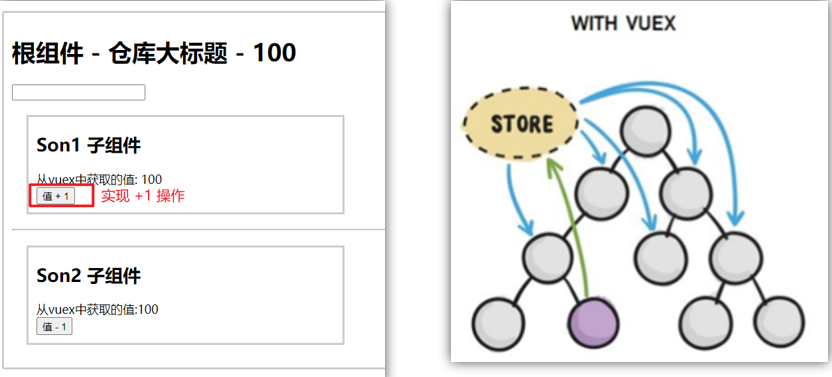
Son1.vue
1 | button @click="handleAdd">值 + 1</button> |
3.开启严格模式
通过 strict: true 可以开启严格模式,开启严格模式后,直接修改state中的值会报错
state数据的修改只能通过mutations,并且mutations必须是同步的
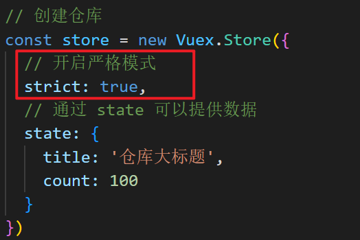
核心概念-mutations
1.定义mutations
1 | const store = new Vuex.Store({ |
2.格式说明
mutations是一个对象,对象中存放修改state的方法
1 | mutations: { |
3.组件中提交 mutations
1 | this.$store.commit('addCount') |
带参数的 mutations
语法
看下面这个案例,每次点击不同的按钮,加的值都不同,每次都要定义不同的mutations处理吗?

提交 mutation 是可以传递参数的 this.$store.commit('xxx', 参数)
2.1 提供mutation函数(带参数)
1 | mutations: { |
2.2 提交mutation
1 | handle ( ) { |
小tips: 提交的参数只能是一个, 如果有多个参数要传, 可以传递一个对象
1 | this.$store.commit('addCount', { |
练习-mutations的减法功能

1.步骤

2.代码实现
Son2.vue
1 | <button @click="subCount(1)">值 - 1</button> |
store/index.js
1 | mutations:{ |
练习-Vuex中的值和组件中的input双向绑定
1.目标
实时输入,实时更新,巩固 mutations 传参语法
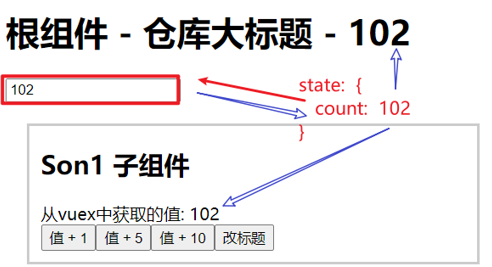
2.实现步骤

3.代码实现
App.vue
1 | <input :value="count" @input="handleInput" type="text"> |
store/index.js
1 | mutations: { |
辅助函数- mapMutations
mapMutations和mapState很像,它把位于mutations中的方法提取了出来,我们可以将它导入
1 | import { mapMutations } from 'vuex' |
上面代码的含义是将mutations的方法导入了methods中,等价于
1 | methods: { |
此时,就可以直接通过this.addCount调用了
1 | <button @click="addCount">值+1</button> |
但是请注意: Vuex中mutations中要求不能写异步代码,如果有异步的ajax请求,应该放置在actions中
核心概念 - actions
state是存放数据的,mutations是同步更新数据 (便于监测数据的变化, 更新视图等, 方便于调试工具查看变化),
actions则负责进行异步操作
说明:mutations必须是同步的
需求: 一秒钟之后, 要给一个数 去修改state

1.定义actions
1 | mutations: { |
2.组件中通过dispatch调用
1 | setAsyncCount () { |

辅助函数 -mapActions
1.目标:掌握辅助函数 mapActions,映射方法
mapActions 是把位于 actions中的方法提取了出来,映射到组件methods中
Son2.vue
1 | import { mapActions } from 'vuex' |
直接通过 this.方法 就可以调用
1 | <button @click="changeCountAction(200)">+异步</button> |
核心概念 - getters
除了state之外,有时我们还需要从state中筛选出符合条件的一些数据,这些数据是依赖state的,此时会用到getters
例如,state中定义了list,为1-10的数组,
1 | state: { |
组件中,需要显示所有大于5的数据,正常的方式,是需要list在组件中进行再一步的处理,但是getters可以帮助我们实现它
1.定义getters
1 | getters: { |
2.使用getters
2.1原始方式-$store
1 | <div>{{ $store.getters.filterList }}</div> |
2.2辅助函数 - mapGetters
1 | computed: { |
1 | <div>{{ filterList }}</div> |
十五、使用小结

核心概念 - module
1.目标
掌握核心概念 module 模块的创建
2.问题
由于使用单一状态树,应用的所有状态会集中到一个比较大的对象。当应用变得非常复杂时,store 对象就有可能变得相当臃肿。
这句话的意思是,如果把所有的状态都放在state中,当项目变得越来越大的时候,Vuex会变得越来越难以维护
由此,又有了Vuex的模块化
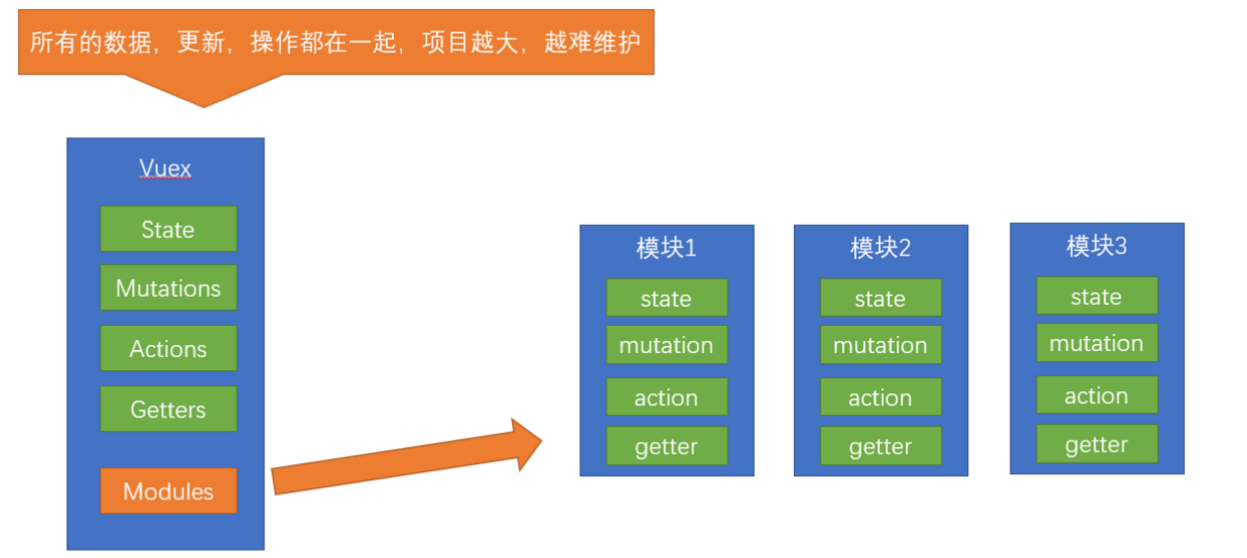
3.模块定义 - 准备 state
定义两个模块 user 和 setting
user中管理用户的信息状态 userInfo modules/user.js
1 | const state = { |
setting中管理项目应用的 主题色 theme,描述 desc, modules/setting.js
1 | const state = { |
在store/index.js文件中的modules配置项中,注册这两个模块
1 | import user from './modules/user' |
使用模块中的数据, 可以直接通过模块名访问 $store.state.模块名.xxx => $store.state.setting.desc
也可以通过 mapState 映射
获取模块内的state数据
1.目标:
掌握模块中 state 的访问语法
尽管已经分模块了,但其实子模块的状态,还是会挂到根级别的 state 中,属性名就是模块名
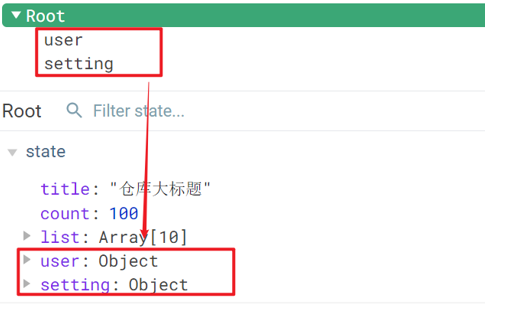
2.使用模块中的数据
- 直接通过模块名访问 $store.state.模块名.xxx
- 通过 mapState 映射:
- 默认根级别的映射 mapState([ ‘xxx’ ])
- 子模块的映射 :mapState(‘模块名’, [‘xxx’]) - 需要开启命名空间 namespaced:true
modules/user.js
1 | const state = { |
3.代码示例
$store直接访问
1 | $store.state.user.userInfo.name |
mapState辅助函数访问
1 | ...mapState('user', ['userInfo']), |
获取模块内的getters数据
1.目标:
掌握模块中 getters 的访问语
2.语法:
使用模块中 getters 中的数据:
- 直接通过模块名访问
$store.getters['模块名/xxx '] - 通过 mapGetters 映射
- 默认根级别的映射
mapGetters([ 'xxx' ]) - 子模块的映射
mapGetters('模块名', ['xxx'])- 需要开启命名空间
- 默认根级别的映射
3.代码演示
modules/user.js
1 | const getters = { |
Son1.vue 直接访问getters
1 | <!-- 测试访问模块中的getters - 原生 --> |
Son2.vue 通过命名空间访问
1 | computed:{ |
获取模块内的mutations方法
1.目标:
掌握模块中 mutation 的调用语法
2.注意:
默认模块中的 mutation 和 actions 会被挂载到全局,需要开启命名空间,才会挂载到子模块。
3.调用方式:
- 直接通过 store 调用 $store.commit(‘模块名/xxx ‘, 额外参数)
- 通过 mapMutations 映射
- 默认根级别的映射 mapMutations([ ‘xxx’ ])
- 子模块的映射 mapMutations(‘模块名’, [‘xxx’]) - 需要开启命名空间
4.代码实现
modules/user.js
1 | const mutations = { |
modules/setting.js
1 | const mutations = { |
Son1.vue
1 | <button @click="updateUser">更新个人信息</button> |
Son2.vue
1 | <button @click="setUser({ name: 'xiaoli', age: 80 })">更新个人信息</button> |
获取模块内的actions方法
1.目标:
掌握模块中 action 的调用语法 (同理 - 直接类比 mutation 即可)
2.注意:
默认模块中的 mutation 和 actions 会被挂载到全局,需要开启命名空间,才会挂载到子模块。
3.调用语法:
- 直接通过 store 调用 $store.dispatch(‘模块名/xxx ‘, 额外参数)
- 通过 mapActions 映射
- 默认根级别的映射 mapActions([ ‘xxx’ ])
- 子模块的映射 mapActions(‘模块名’, [‘xxx’]) - 需要开启命名空间
4.代码实现
需求:

modules/user.js
1 | const actions = { |
Son1.vue 直接通过store调用
1 | <button @click="updateUser2">一秒后更新信息</button> |
Son2.vue mapActions映射
1 | <button @click="setUserSecond({ name: 'xiaoli', age: 80 })">一秒后更新信息</button> |
Vuex模块化的使用小结
1.直接使用
- state –> $store.state.模块名.数据项名
- getters –> $store.getters[‘模块名/属性名’]
- mutations –> $store.commit(‘模块名/方法名’, 其他参数)
- actions –> $store.dispatch(‘模块名/方法名’, 其他参数)
2.借助辅助方法使用
1.import { mapXxxx, mapXxx } from ‘vuex’
computed、methods: {
// …mapState、…mapGetters放computed中;
// …mapMutations、…mapActions放methods中;
…mapXxxx(‘模块名’, [‘数据项|方法’]),
…mapXxxx(‘模块名’, { 新的名字: 原来的名字 }),
}
2.组件中直接使用 属性 {{ age }} 或 方法 @click="updateAge(2)"






